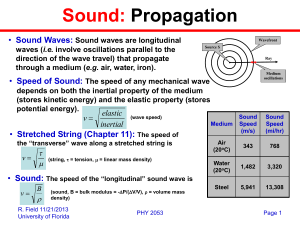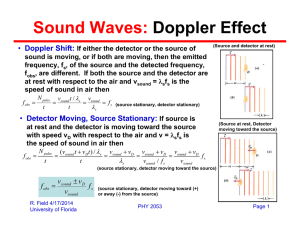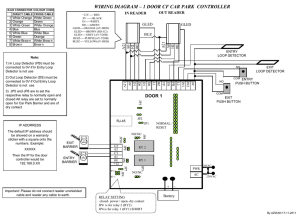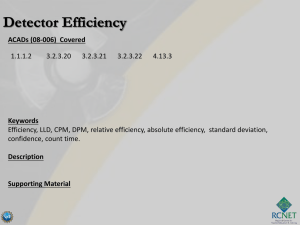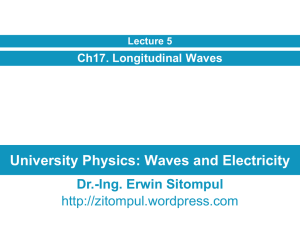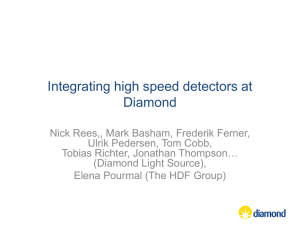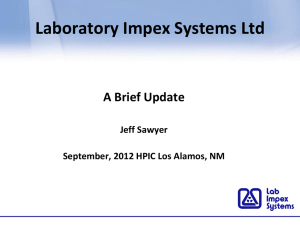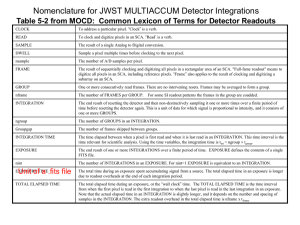2053_Lecture_11-26-13
advertisement
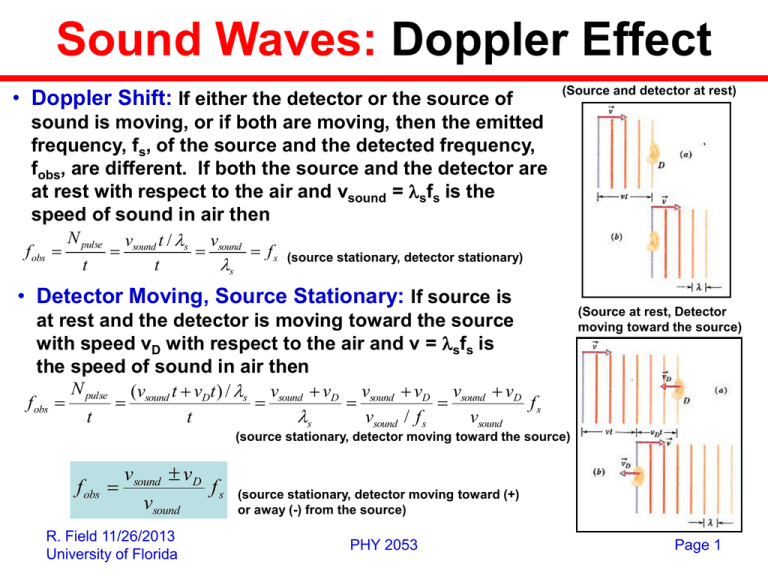
Sound Waves: Doppler Effect • Doppler Shift: If either the detector or the source of (Source and detector at rest) sound is moving, or if both are moving, then the emitted frequency, fs, of the source and the detected frequency, fobs, are different. If both the source and the detector are at rest with respect to the air and vsound = sfs is the speed of sound in air then N pulse vsound t / s vsound f obs f s (source stationary, detector stationary) t t s • Detector Moving, Source Stationary: If source is at rest and the detector is moving toward the source with speed vD with respect to the air and v = sfs is the speed of sound in air then N pulse (vsound t vDt ) / s vsound vD vsound vD vsound vD f obs fs t t s vsound / f s vsound (Source at rest, Detector moving toward the source) (source stationary, detector moving toward the source) f obs vsound vD fs vsound R. Field 11/26/2013 University of Florida (source stationary, detector moving toward (+) or away (-) from the source) PHY 2053 Page 1 Sound Waves: Doppler Effect • Detector Stationary, Source Moving: If detector (detector stationary, source moving toward the detector) is at rest and the source is moving toward the detector with speed vs with respect to the air and vsound = sfs is the speed of sound in air and Ts = 1/fs is the time between emitted pulses then v vsound vsound vsound f obs sound fs obs vsound Ts vsTs vsound / f s vs / f s vsound vs (detector stationary, source moving toward the detector) f obs vsound fs vsound vs (detector stationary, source moving toward (-) or away (+) from the source) • Detector and Source Moving: If detector is moving with speed vD and the source is moving with speed vs with respect to the air then there are the following four possibilities: vsound vsound vsound vD v vD f obs f s Source Detector Detector f obs sound f s Source vsound vs vsound vs f obs v vD sound f s Source vsound vs R. Field 11/26/2013 University of Florida vsound Detector f obs v vD sound fs vsound vs PHY 2053 vsound Source Detector Page 2 Summary: Doppler Effect • Detector and Source Moving: If detector is moving with speed vD and the source is moving with speed vs, and vsound = sfs is the speed of sound in air then the observed frequency at the detector is f obs vsound vD fs vsound vs Take vD positive if the detector is moving in the direction of the propagation of the sound wave. Take vD negative if the detector is moving opposite the direction of propagation of the sound wave. Take vs positive if the source is moving in the direction of propagation of the sound wave. Take vS negative if the source is moving opposite the direction of propagation of the sound wave. R. Field 11/26/2013 University of Florida PHY 2053 Page 3 Doppler Effect: Examples • A low flying airplane skims the ground at a speed of 200 m/s as it approaches a stationary observer. A loud horn whose fundamental frequency is 400 Hz is carried on the plane. What frequency does the ground observer hear? (Assume that the speed of sound in the air is 343 m/s.) Answer: 959 Hz f obs vsound 1 400Hz fs fs 959Hz vsound vs 1 vs / vsound 1 (200/ 343) • If instead the horn were on the ground, what frequency would the airplane pilot hear as she approached? Answer: 633 Hz f obs vsound vs f s (1 vs / vsound ) f s vsound (1 200/ 343)(400Hz) 633Hz R. Field 11/26/2013 University of Florida PHY 2053 Page 4 Doppler Effect: Example • The pitch of the sound from a race car engine drops the musical interval of a fourth when it passes the spectators. This means the frequency of the sound after passing is 0.75 times what it was before. How fast is the race can moving? (Assume that the speed of sound in the air is 343 m/s.) Answer: 49.0 m/s ftoward vsound fs vsound vs f away ftoward f away vsound fs vsound vs vsound vs vsound vs 1 1 0.75 vsound vs (343m / s) 49.0m / s 1 0.75 1 R. Field 11/26/2013 University of Florida PHY 2053 Page 5 Doppler Effect: Example • A stationary motion detector sends sound waves of frequency of 600 Hz toward a truck that is speeding away. The waves sent out by the detector are reflected off the truck and then are received back at the detector. If the frequency of the waves received back at the detector is 400 Hz, what is the speed of the receding truck (in m/s)? (Take the speed of sound to be 343 m/s.) Answer: 68.6 m/s Part 1: The truck is the detector and ftruck is the frequency observed by the truck and f0 is the original frequency emitted by the motion detector which is the source. f truck vsound vtruck f0 vsound Part 2: The truck is now the source emitting frequency ftruck and the motion detector is the detector which observes frequency fobs. f obs vsound v vtruck f truck sound f0 vsound vtruck vsound vtruck f f vtruck 0 obs f 0 f obs R. Field 11/26/2013 University of Florida f obs vsound vtruck f0 vsound vtruck 600Hz 400Hz vsound (343m / s) 68.6m / s 600Hz 400Hz PHY 2053 Page 6 Doppler Effect: Example • In the figure, a French submarine and a U.S. submarine move toward each other during maneuvers in motionless water in the North Atlantic. The French sub moves at speed vF = 100 km/h, and the U.S. sub at vUS = 200 km/h. The French sub sends out a sonar signal (sound wave in water) at 1,000 Hz. Sonar waves travel at 5000 km/h. What frequency is detected by the French sub in the signal reflected back to it by the U.S. sub? Answer: 1,127.6 Hz Part 1: The US sub is the detector and fUS is the frequency observed by the US sub and f0 is the original frequency emitted by the French sub which is the source. fUS vsound vUS f0 vsound vF Part 2: The US sub is now the source emitting frequency fUS and the French sub is the detector which observes frequency fobs. f obs vsound vF (v vF )(vsound vUS ) fUS sound f0 vsound vUS (vsound vUS )(vsound vF ) (5000km / h 100km / h)(5000km / h 200km / h) (1000Hz) 1127.6 Hz (5000km / h 200km / h)(5000km / h 100km / h) R. Field 11/26/2013 University of Florida PHY 2053 Page 7
